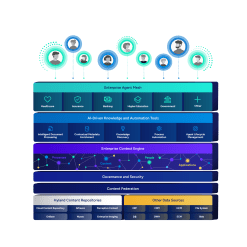Digitize employee file management
Convert paper files and file shares to electronic records to manage content across the employee life cycle.

Harness the power of a unified content, process and application intelligence platform to unlock the value of enterprise content.
Learn more
Automate your document-centric processes with AI-powered document capture, separation, classification, extraction and enrichment.
Learn about Hyland IDPIt's your unique digital evolution … but you don't have to face it alone. We understand the landscape of your industry and the unique needs of the people you serve.
 Overview of industries
Overview of industries
Countless teams and departments have transformed the way they work in accounting, HR, legal and more with Hyland solutions.
 Overview of departments
Overview of departments
We are committed to helping you maximize your technology investment so you can best serve your customers.
 Overview of services
Overview of services

Discover why Hyland is trusted by thousands of organizations worldwide.
Hear from our customers
Our exclusive partner programs combine our strengths with yours to create better experiences through content services.
Overview of partners
Join The Shift newsletter for the latest strategies and expert tips from industry leaders. Discover actionable steps to stay innovative.
Register now
Hyland connects your content and systems so you can forge stronger connections with the people who matter most.
Learn about HylandWith our modern, open and cloud-native platforms, you can build strong connections and keep evolving.
 Dig deeper
Dig deeper

Hyland’s employee file management software improves the worker experience and secures sensitive data.
Are disconnected employee information sources causing delays? Are you wasting time searching for employee files? We can help.
Convert paper files and file shares to electronic records to manage content across the employee life cycle.

Link HR processes with records management procedures to reduce lost or incomplete documents.

Provide consistent experiences and access to information regardless of where employees and HR staff work.

Associate HR system data with employee content from one repository — all accessible within HR system screens.


Discover how Heinen’s delivered on its expansion plan by transforming its HR processes with Hyland.
The grocery store chain accelerated vital HR processes and grew considerably without adding additional HR staff.
Organize and secure records seamlessly with OnBase while maintaining compliance and improving productivity. Watch now to transform your records management approach.
See how Toyota North America streamlined HR operations with Alfresco, boosting efficiency and enabling smarter HR practices. Watch now to discover the impact.
We have received your message and will be in contact shortly.
We have received your message and will be in contact shortly.